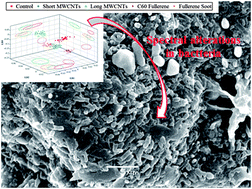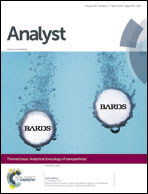Mid-infrared spectroscopic assessment of nanotoxicity in Gram-negative vs. Gram-positive bacteria†
Abstract
Nanoparticles appear to induce toxic effects through a variety of mechanisms including generation of reactive oxygen species (ROS), physical contact with the cell membrane and indirect catalysis due to remnants from manufacture. The development and subsequent increasing usage of nanomaterials has highlighted a growing need to characterize and assess the toxicity of nanoparticles, particularly those that may have detrimental health effects such as carbon-based nanomaterials (CBNs). Due to interactions of nanoparticles with some reagents, many traditional toxicity tests are unsuitable for use with CBNs. Infrared (IR) spectroscopy is a non-destructive, high throughput technique, which is unhindered by such problems. We explored the application of IR spectroscopy to investigate the effects of CBNs on Gram-negative (Pseudomonas fluorescens) and Gram-positive (Mycobacterium vanbaalenii PYR-1) bacteria. Two types of IR spectroscopy were compared: attenuated total reflection Fourier-transform infrared (ATR-FTIR) and synchrotron radiation-based FTIR (SR-FTIR) spectroscopy. This showed that Gram-positive and Gram-negative bacteria exhibit differing alterations when exposed to CBNs. Gram-positive bacteria appear more resistant to these agents and this may be due to the protection afforded by their more sturdy cell wall. Markers of exposure also vary according to Gram status; Amide II was consistently altered in Gram-negative bacteria and carbohydrate altered in Gram-positive bacteria. ATR-FTIR and SR-FTIR spectroscopy could both be applied to extract biochemical alterations induced by each CBN that were consistent across the two bacterial species; these may represent potential biomarkers of nanoparticle-induced alterations. Vibrational spectroscopy approaches may provide a novel means of fingerprinting the effects of CBNs in target cells.

- This article is part of the themed collection: Analytical Toxicology of Nanoparticles

 Please wait while we load your content...
Please wait while we load your content...